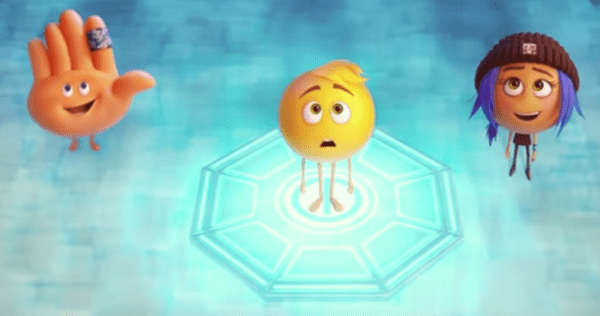The only thing I had heard about The Emoji Movie was that it was one of the worst movies of all time. Rotten Tomatoes gave it one star. The professional critics hated it and so did the amateur critics. Reviewers on Rotten Tomatoes said,
From its cringey premise, there was little hope that The Emoji Movie would be anything but awful. The premonition is correct.
Not just bad, but it’s offensively boring, and tedious.
One of the worst films of the year. It’s the poop emoji personified.
A cinema release perhaps without equal this year in terms of how shockingly dreadful it is.
Poop emoji personified! That’s funny. But it was the middle of August and my kids were getting restless. They pleaded, “We want to see The Emoji Movie!” I have a weakness for the puppy dog eyes of my three children, so against my better judgement, we went to see the emojis.
I was expecting a horrible movie with a stupid plot and no redeeming qualities. But what my children and I got instead was a lesson in Christian salvation.
Saved from What? – The Emoji Movie and the Human Problem
The Emoji Movie is about the inner life of a cell phone owned by Alex, a high school freshman. The emojis live in an app called “Textopolis,” where they perform their designated tasks. Each emoji has one function. For example, the main emoji of the film is Gene, who was born to be an emotionless “meh.” But Gene had a malfunction that caused him to have every emotion in Textopolis.
Gene couldn’t contain his emotions. They burst out of him, causing Alex’s phone to burst out in music and awkward sounds during school. Embarrassed by his phone’s malfunctioning, Alex made an appointment at a cell phone store to have his phone wiped out.
Led by the original emoji, Smiler, the leaders of Textopolis unite against Gene. They accuse him of causing all the problems within Textopolis. Smiler decides that their only hope to avoid being wiped out is to delete Gene, so she sends giant anti-virus bots to kill him.
The Emoji movie effectively reveals the problem that has plagued humanity from the beginning of our history. Smiler leads Textopolis in what the Judeo-Christian tradition calls “sin.” Sin is the proclivity we have to blame others for the problems of our community. This is the essential problem that the Bible reveals from the very beginning. In the Genesis account of the first humans, Adam blames Eve for their problems, Eve then blames the serpent. The cycle of blame escalates in the following generations with murder. Cain kills Abel and Lamech threatens sevenfold vengeance on anyone who hurts him. By Noah’s generation, humans are consumed by apocalyptic violence that threatens the whole world. And that’s just the first 6 chapters of the Bible!
The Emojis encounter an apocalyptic moment of violence. Their whole world is about to be destroyed. This causes what the anthropologist René Girard calls a “sacrificial crisis.” In order to avert destruction, someone must be blamed and sacrificed for the violence that threatens our community.
The problem with sacrifice is that it “works.” It “works” because after an act of violence a sense of peace does descend upon us. We think that the cause of our problems has been destroyed. But sacrificial violence never really works, because it doesn’t actually solve the problem of violence. The fact that it “works” only perpetuates the problem.
How the Emojis Reveal Salvation
How are we saved from this cycle of violence that can escalate to apocalyptic destruction? The Emoji movie reveals that salvation comes not through more acts of violence, but through acts of nonviolent love.
Gene escapes Textopolis with his friend Hi-5. Outside of Textopolis, they encounter the other apps in the phone. They enter a piracy app, where they meet Jailbreak, another escaped emoji who specializes in hacking. Jailbreak claims she can help Gene if they go to the phone’s Dropbox app, where she can save Gene by reprogramming him to be a real “Meh.” Jailbreak seeks her own salvation, too. She wants to escape the problems of the cell phone by living in “The Cloud.”
So far, The Emoji Movie mirrors what many Christians believe about salvation. First, many Christians believe that some people are born defective and they need to change. The LGBTQ community is an unfortunately tragic example of this. Like Smiler and the other leaders of Textopolis united against Gene, many Christians have united against the LGBTQ community and demanded that they change in order to be saved. These Christians believe a lie and then they blame the LGBTQ community for all kinds of “problems,” including hurricanes and other natural disasters. Unfortunately, in The Emoji Movie, Gene begins to believe the lie that he’s defective and needs to change in order to find salvation.
Second, many Christians believe that this world is evil and salvation can only be accomplished by escaping it. Despite the fact that this is one of the most dominant beliefs in Christianity, it’s an ancient heresy. The modern view of the rapture where the true believers will escape the evil earth and ascend to the clouds of heaven is actually an ancient heresy called Gnosticism. Gnostics believed the world was essentially evil and salvation comes from escaping it and entering into the realm of the clouds.
Salvation Isn’t Escaping this World
True salvation comes from heaven and earth uniting together. For Jesus, the Kingdom of Heaven isn’t about escaping to the clouds. Rather, it’s more like a party on earth where everyone is invited.
Gene, Hi-5, and Jailbreak arrive at the Dropbox. But just before Gene is transformed by Jailbreak, an anti-Virus bot captures Hi-5 and drags him to the trash, the movie’s version of hell. No emoji would ever want to go to the trash. But here, at this moment, Gene forsakes his own salvation to rescue his friend. He convinces Jailbreak join him and enter the trash in order to save their friend.
The three return to the Dropbox, but before Gene is transformed into a Meh, he expresses his love for Jailbreak. She likes him, but chooses to continue her plan to live in the Cloud. Gene feels rejected. He walks away and turns into a “Meh” all by himself. Heartbroken, Gene lost the will to live and was quickly captured by Smiler’s bot and taken back to Textopolis to be deleted.
Hi-5 tells the news to Jailbreak. She’s moved with compassion for Gene, so she forsakes her salvation of entering the Cloud in order to save Gene. Jailbreak and Hi-5 enter Textopolis just before Gene is deleted by the upgraded bot. Hi-5 climbs on top of the bot and pushes the bot’s deactivation button. The bot deactivates and lands on Smiler.
Throughout the movie, there is no plan to seek revenge upon Smiler. Gene, Hi-5, and Jailbreak do not mimic Smiler’s violence and hatred for them. They remain non-violent in the face violence. The giant bot falls on Smiler. She is defeated by her own violent weapon.
Smiler survives, but she loses her social power within Textopolis. The emojis find salvation not by entering the Cloud or by transforming Gene into a Meh. After Jailbreak risks her life to help Gene, he reclaims all of his emotions, which allows him to save Textopolis from being wiped out by Alex. The emojis celebrate by throwing a party where everyone is invited.
As the credits roll, we see that Smiler isn’t at the party. She’s at the “loser’s lounge.” I’d rather Smiler be at the party, but it could be that while everyone is invited to the Kingdom of Heaven, some will choose anger, hatred, and bitterness instead.
What is Salvation?
Okay, so The Emoji Movie isn’t going to win an Oscar. But so what? I have one word for all the haters of this movie – meh. The movie provides a good corrective to bad ideas about Christian salvation. Salvation doesn’t come from escaping the earth, but by transforming the way we relate to one another – away from violent sacrifice and toward inclusive community. That’s the ultimate message of The Emoji Movie, and it’s the message of the Gospel.
Image: Screenshot from YouTube.
Stay in the loop! Like Teaching Nonviolent Atonement on Facebook!












